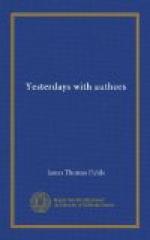The portrait I am looking at was made by Rowse (an exquisite drawing), and is a very truthful representation of the head of Nathaniel Hawthorne. He was several times painted and photographed, but it was impossible for art to give the light and beauty of his wonderful eyes. I remember to have heard, in the literary circles of Great Britain, that, since Burns, no author had appeared there with a finer face than Hawthorne’s. Old Mrs. Basil Montagu told me, many years ago, that she sat next to Burns at dinner, when he appeared in society in the first flush of his fame, after the Edinburgh edition of his poems had been published. She said, among other things, that, although the company consisted of some of the best bred men of England, Burns seemed to her the most perfect gentleman among them. She noticed, particularly, his genuine grace and deferential manner toward women, and I was interested to hear Mrs. Montagu’s brilliant daughter, when speaking of Hawthorne’s advent in English society, describe him in almost the same terms as I had heard her mother, years before, describe the Scottish poet. I happened to be in London with Hawthorne during his consular residence in England, and was always greatly delighted at the rustle of admiration his personal appearance excited when he entered a room. His bearing was modestly grand, and his voice touched the ear like a melody.
Here is a golden curl which adorned the head of Nathaniel Hawthorne when he lay a little child in his cradle. It was given to me many years ago by one near and dear to him. I have two other similar “blossoms,” which I keep pressed in the same book of remembrance. One is from the head of John Keats, and was given to me by Charles Cowden Clarke, and the other graced the head of Mary Mitford, and was sent to me after her death by her friendly physician, who watched over her last hours. Leigh Hunt says with a fine poetic emphasis,
“There seems a love
in hair, though it be dead.
It is the gentlest, yet the
strongest thread
Of our frail plant,—a
blossom from the tree
Surviving the proud trunk;—as
though it said,
Patience and Gentleness is
Power. In me
Behold affectionate eternity.”
There is a charming old lady, now living two doors from me, who dwelt in Salem when Hawthorne was born, and, being his mother’s neighbor at that time (Mrs. Hawthorne then lived in Union Street), there came a message to her intimating that the baby could be seen by calling. So my friend tells me she went in, and saw the little winking thing in its mother’s arms. She is very clear as to the beauty of the infant, even when only a week old, and remembers that “he was a pleasant child, quite handsome, with golden curls.” She also tells me that Hawthorne’s mother was a beautiful woman, with remarkable eyes, full of sensibility and expression, and that she was a person of singular purity of mind. Hawthorne’s father, whom my friend knew well, she describes as a warm-hearted and kindly man, very fond of children. He was somewhat inclined to melancholy, and of a reticent disposition. He was a great reader, employing all his leisure time at sea over books.




